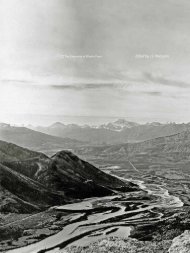C Ihe Ladies c cu. V'VVAN - History and Classics, Department of
C Ihe Ladies c cu. V'VVAN - History and Classics, Department of
C Ihe Ladies c cu. V'VVAN - History and Classics, Department of
- No tags were found...
You also want an ePaper? Increase the reach of your titles
YUMPU automatically turns print PDFs into web optimized ePapers that Google loves.
264 Notes to Pages 63-67, :109Fannie Puniovaluk. She <strong>and</strong> Stefansson "had only one child,my father, who now lives at Aklavik, where he owns a freighter<strong>and</strong> hunts <strong>and</strong> traps in his spare time. My gr<strong>and</strong>mother diedmany years ago. Since then my gr<strong>and</strong>father moved to theUnited States ..,. Although I have never met him I have alwaysbeen proud <strong>of</strong> him, <strong>and</strong> feel that I do know him because <strong>of</strong> thestories my dad has told me about him" (Georgina Stefansson25). The explorer never did acknowledge his native <strong>of</strong>fspring(Hunt 120), although in My Life with the Eskimo he mentioned thathe travelled with "an elderly country-woman ... namedPannigabluk, whose husb<strong>and</strong> had died the year before" (n7).Field Note for Wednesd'9' 23JuneNot surprisingly, the first entry in Dorrien Smith's field notefor this date reports on the doctor's house call to her aboardthe steamer, as well as his verdict: "My foot keeps us here for afortnight. "shupacks <strong>of</strong> fur or skin: babies tightly bound on backs inhoodsThe latter are the women's amaut, the former are theirfootwear, which Vyvyan spelled phonetically, <strong>and</strong> which also isspelled "shoepak." This footwear consists <strong>of</strong>insulated rubberlowers <strong>and</strong> uppers <strong>of</strong> canvas or leather, or, as Vyvyan observedin Aklavik, caribou fur or seal skin. It is possible that a bootmade entirely <strong>of</strong> rubber was introduced by the Americanwhalers at Herschel Isl<strong>and</strong> <strong>and</strong> was modified for local use with acomplement <strong>of</strong> warmer materials than rubber, leather, or felt.CHAPTER 11: HARBOUR OF WRECKED MENWhile the field notes mention "city <strong>of</strong> the dead" (26june) <strong>and</strong>"wrecked" men <strong>and</strong> women <strong>of</strong> the North (njune), thischapter's extensive sketches are Vyvyan's later creations.Similar ruined figures appear in early adventure novels set inthe North by writers such as Americans Rex Beach <strong>and</strong> DillonWallace <strong>and</strong> Canadian Gilbert Parker. Vyvyan's celebration <strong>of</strong>the RCMP as the exception to this pattern is typical <strong>of</strong> not onlythe anecdotes she records in the field notes about theirexploits, but also the conventions <strong>of</strong> a long tradition <strong>of</strong> adventurenovels featuring mounties, which portrayed the North asthe proving ground <strong>of</strong> young manhood."The steamer brought in drink," he said. "The nrst liquorin nine months. They are all under the covers today. Deaddrunk."In her letter <strong>of</strong>20june to her mother, Vyvyan noted that "thedrunkenness up here is something awful-among white men."As for communications by wireless <strong>and</strong> airplane, both <strong>of</strong>them were, at the time <strong>of</strong> our journey, in their early stages <strong>of</strong>development in northern CanadaThe situation was, indeed, about to change rapidly. The firstairplanes were seen on the Mackenzie River in the winter <strong>of</strong>1928-29, <strong>and</strong> thirty-year-old C.H. "Punch" Dickins, a veteran<strong>of</strong> the Royal Flying Corps in the First World War, reachedAklavik by air for the first time on Dominion Day 1929(Bonnycastle, Gentleman 105). Reliable postal service quicklybecame the first regular cargo aboard northern flights, RichardBonnycastle reported reading Winnipeg newspapers only threedays old when in Fort Good Hope.That Vyvyan mentions visits to the wireless stations atseveral posts might suggest that she was half-expecting acommunication to be awaiting her. However, her apparentlyinordinate interest might also be attributable to their novelty.The NWT <strong>and</strong> Yukon Radio System had just come into being.Sheer distances had dissuaded the <strong>Department</strong> <strong>of</strong> the Interiorfrom plans to erect <strong>and</strong> maintain a telegraph line. but radiotelegraphcould function through air waves along a system <strong>of</strong>relay stations. The Royal Canadian Corps <strong>of</strong> Signals wasaSSigned the task <strong>of</strong> erecting that system <strong>of</strong> stations. Led byMajor W.A. Steel, a party <strong>of</strong> the RCCS installed stations atMayo <strong>and</strong> Dawson, Yukon. With these, the System opened on20 October 1923. In 1924, the terminal system at Edmonton<strong>and</strong> the control station at Fort Simpson were opened. In 1925,the equipment deSignated for the station at Fort Smith wasseconded for the summer to the SS Distributor so that GovernorGeneral Byng could be supplied with continuous service. It wasoperational at Fort Smith once his return trip downriver wascompleted. After near-disaster delayed the installation atHerschel Isl<strong>and</strong> in 1924, Lt H.A. Young made his way fromthere to Aklavik in April 1925. Asjim Koe's memoir confirms,the system was installed <strong>and</strong> running there in October <strong>of</strong> thatyear, thus making possible Cunliffe's reservation, by way <strong>of</strong>Brabant in Edmonton <strong>and</strong> Parsons at Aklavik, <strong>of</strong> a canoe forthe women, while the summer-only station at Herschel Isl<strong>and</strong>opened in 1926 (Moir 276-79). Young, who would go on to
















